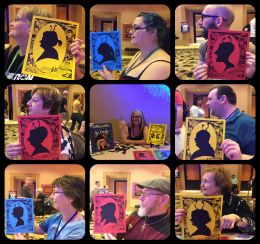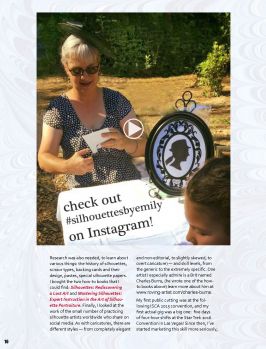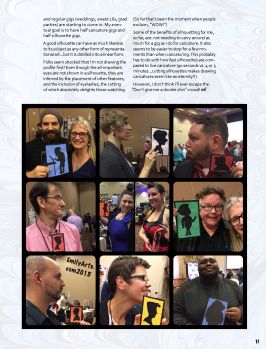Difference between revisions of "Caricaturist to Silhouettist (and back again)"
TheChairman (talk | contribs) |
TheChairman (talk | contribs) |
||
| Line 76: | Line 76: | ||
design, pastes, special silhouette papers. | design, pastes, special silhouette papers. | ||
I bought the two how-to books that I | I bought the two how-to books that I | ||
| − | could find: [ | + | could find: [https://www.amazon.com/Silhouettes-Rediscovering-Kathryn-K-Flocken/dp/0970115105 Silhouettes: Rediscovering a Lost Art] and [https://www.amazon.com/Mastering-Silhouettes-Instruction-Silhouette-Portraiture/dp/0811701492/ref=pd_lpo_sbs_14_t_1?_encoding=UTF8&psc=1&refRID=1HWQSMB3VQKZDJZKHFFX Mastering Silhouettes: Expert Instruction in the Art of Silhouette Portraiture]. Finally, I looked at the |
work of the small number of practicing | work of the small number of practicing | ||
silhouette artists worldwide who share on | silhouette artists worldwide who share on | ||
Revision as of 10:14, 1 March 2021
 | |
| Author | Emily Byrne |
|---|---|
| Subject | Article, Silhouette |
| Published | EF Issue 20??.? |
| Website |
|
Article Transcript
Portraits with intense likenesses have always fascinated me, so when I fell into the amazing world of caricature twenty years ago, I’d found my professional calling (#caricaturesbyemily). As a self-taught caricaturist (way back before the time of internet tutorials and videos) my incessant practice sketching of family and friends included front and 3/4 views only. That’s what I’d been exposed to from the exactly one caricature artist I’d seen at an art festival.
There was no inkling for me that a fine tradition of profile caricatures also existed. Later, once I’d experienced the sheer onslaught of my first ISCA (then NCN) convention in 2003, I admired the work of a few devotees to the side-view caricature, but it was sadly almost out-of-fashion (sorry, Tad!) by then, and everyone was doing full-face work.
Eleven years later, the profile caricature reappeared in a different guise: two master silhouette artists with sharp scissors and even sharper wits turned up at various caricature conventions and completely inspired me. In 2014, I attended the DrawInn Vlagtwedde convention in the Netherlands, hosted by ISCA member Johanna Veerenhuis (see her article in this issue), which was attended by some of the best caricaturists in Europe… including Jeanet Willems, master silhouettist who proceeded to cut hilarious linear caricatures of everyone with her gigantic shears. Then at the annual ISCA convention later that year, Mongolian artist Turburam Sandagdorj came and shocked us all with his intricately detailed likenesses cut by a tiny pair of nail scissors.
My first silhouette attempts were made at home after seeing these two pros in action. I had the observational skills already, from my many years of live drawing. However, I still had many aspects to learn: mainly, accuracy in translating what I saw to what I cut, and to be able to cut them rapidly and uniformly in size.
Research was also needed, to learn about various things: the history of silhouettes, scissor types, backing cards and their design, pastes, special silhouette papers. I bought the two how-to books that I could find: Silhouettes: Rediscovering a Lost Art and Mastering Silhouettes: Expert Instruction in the Art of Silhouette Portraiture. Finally, I looked at the work of the small number of practicing silhouette artists worldwide who share on social media. As with caricatures, there are different styles — from completely elegant and non-editorial, to slightly skewed, to overt caricature) — and skill levels, from the generic to the extremely specific. One artist I especially admire is a Brit named Charles Burns, (he wrote one of the how-to books above) learn more about him at www.roving-artist.com/charles-burns.
My first public cutting was at the following ISCA 2015 convention, and my first actual gig was a big one: five days of four-hour shifts at the Star Trek 2016 Convention in Las Vegas! Since then, I’ve started marketing this skill more seriously, and regular gigs (weddings, sweet 16s, grad parties) are starting to come in. My eventual goal is to have half caricature gigs and half silhouette gigs.
A good silhouette can have as much likeness to its subject as any other form of representational art…but it is distilled into a linear form.
Folks seem shocked that I’m not drawing the profile first! Even though the all-important eyes are not shown in a silhouette, they are inferred by the placement of other features, and the inclusion of eyelashes, the cutting of which absolutely delights those watching. (So far that’s been the moment when people exclaim, “WOW!”)
Some of the benefits of silhouetting for me, so far, are: not needing to carry around as much for a gig as I do for caricature. It also seems to be easier to stop for a few moments than when caricaturing. This probably has to do with how fast silhouettes are compared to live caricature (90 seconds vs. 4 or 5 minutes…cutting silhouettes makes drawing caricatures seem like an eternity!!)
However, I don’t think I’ll ever escape the “Don’t give me a double chin” crowd!
YouTube Video
This Navigation box may not show up on mobile browsers. Please see Exaggerated Features Issue 2017.3 for the full contents of this issue if the navigation box does not display.


